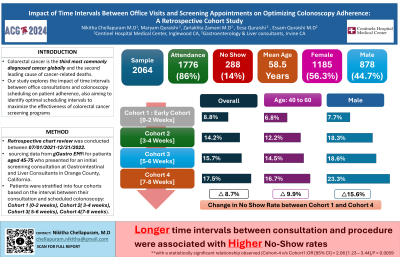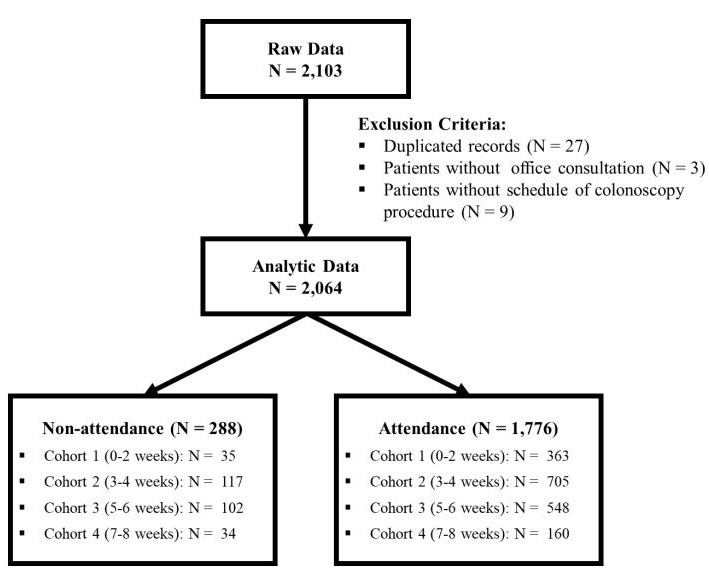Tuesday Poster Session
Category: Colorectal Cancer Prevention
P3855 - Impact of Time Intervals Between Office Visits and Screening Appointments on Optimizing Colonoscopy Adherence: A Retrospective Cohort Study
Tuesday, October 29, 2024
10:30 AM - 4:00 PM ET
Location: Exhibit Hall E

Has Audio

Nikitha Chellapuram, MD
Centinela Hospital Medical Center
Los Angeles, CA
Presenting Author(s)
Nikitha Chellapuram, MD1, Maryam Quraishi, 2, Zarlakhta Zamani, MD1, Eesa Quraishi, 3, Essam Quraishi, MD4
1Centinela Hospital Medical Center, Los Angeles, CA; 2University of Southern California, Irvine, CA; 3University of California Irvine, Irvine, CA; 4Gastroenterology and Liver Consultants, Irvine, CA
Introduction: Colorectal cancer is the third most commonly diagnosed cancer globally and the second leading cause of cancer-related deaths. Screening is crucial for early detection and significantly improving survival rates. Our study explores the impact of time intervals between office consultations and colonoscopy scheduling on patient adherence, also aiming to identify optimal scheduling intervals to maximize the effectiveness of colorectal cancer screening programs.
Methods: Retrospective chart review was conducted between 07/01/2021-12/31/2022, sourcing data from gGastro EMR for patients aged 45-75 who presented for an initial screening consultation at Gastrointestinal and Liver Consultants in Orange County, California. Patients were stratified into four cohorts based on the interval between their consultation and scheduled colonoscopy: 0-2 weeks, 3-4 weeks, 5-6 weeks, and 7-8 weeks. We employed detailed statistical analyses, including correlation analysis and logistic regression, to examine the data comprehensively.
Results: Analytic sample comprised 2064 patients(Figure 1),categorised into attendance(86%,1776) and non-attendance(14%,288) .Mean age of the population 58.5 years,majority being females(56.3%,1185).More than half patients belonged to cohort-2(39.8%,822) and cohort-3(31.4%,650).Successful completion rate was noted in cohort-1(91.2%,363 ) followed by cohort-2(85.8%,705).Those with non-attendance belonged to cohort-4(17.5%,34) and cohort-3(15.7%,102).
Statistically significant 8.7% difference in the no-show rate was observed between early cohort(0-2 weeks) and late cohort(7-8 weeks).Patients aged 45-60 were 9.9% more likely to be compliant than older patients(p< 0.05).Females demonstrated a 15.6% higher compliance rate than males(p< 0.05).Longer time intervals between consultation and procedure were associated with higher no-show rates,with a statistically significant relationship observed (Cohort-4 v/s Cohort-1:OR [95% CI] = 2.06 [1.23 – 3.44],P = 0.0059)
Discussion: Our study underscores the crucial role of timing between the consultation and colonoscopy in improving patient attendance. Scheduling appointments within 0-2 weeks or 3-4 weeks after the initial consultation significantly increased the likelihood of patients attending. This strategy can effectively enhance participation in essential health screenings and advance patient care.

Note: The table for this abstract can be viewed in the ePoster Gallery section of the ACG 2024 ePoster Site or in The American Journal of Gastroenterology's abstract supplement issue, both of which will be available starting October 27, 2024.
Disclosures:
Nikitha Chellapuram, MD1, Maryam Quraishi, 2, Zarlakhta Zamani, MD1, Eesa Quraishi, 3, Essam Quraishi, MD4. P3855 - Impact of Time Intervals Between Office Visits and Screening Appointments on Optimizing Colonoscopy Adherence: A Retrospective Cohort Study, ACG 2024 Annual Scientific Meeting Abstracts. Philadelphia, PA: American College of Gastroenterology.
1Centinela Hospital Medical Center, Los Angeles, CA; 2University of Southern California, Irvine, CA; 3University of California Irvine, Irvine, CA; 4Gastroenterology and Liver Consultants, Irvine, CA
Introduction: Colorectal cancer is the third most commonly diagnosed cancer globally and the second leading cause of cancer-related deaths. Screening is crucial for early detection and significantly improving survival rates. Our study explores the impact of time intervals between office consultations and colonoscopy scheduling on patient adherence, also aiming to identify optimal scheduling intervals to maximize the effectiveness of colorectal cancer screening programs.
Methods: Retrospective chart review was conducted between 07/01/2021-12/31/2022, sourcing data from gGastro EMR for patients aged 45-75 who presented for an initial screening consultation at Gastrointestinal and Liver Consultants in Orange County, California. Patients were stratified into four cohorts based on the interval between their consultation and scheduled colonoscopy: 0-2 weeks, 3-4 weeks, 5-6 weeks, and 7-8 weeks. We employed detailed statistical analyses, including correlation analysis and logistic regression, to examine the data comprehensively.
Results: Analytic sample comprised 2064 patients(Figure 1),categorised into attendance(86%,1776) and non-attendance(14%,288) .Mean age of the population 58.5 years,majority being females(56.3%,1185).More than half patients belonged to cohort-2(39.8%,822) and cohort-3(31.4%,650).Successful completion rate was noted in cohort-1(91.2%,363 ) followed by cohort-2(85.8%,705).Those with non-attendance belonged to cohort-4(17.5%,34) and cohort-3(15.7%,102).
Statistically significant 8.7% difference in the no-show rate was observed between early cohort(0-2 weeks) and late cohort(7-8 weeks).Patients aged 45-60 were 9.9% more likely to be compliant than older patients(p< 0.05).Females demonstrated a 15.6% higher compliance rate than males(p< 0.05).Longer time intervals between consultation and procedure were associated with higher no-show rates,with a statistically significant relationship observed (Cohort-4 v/s Cohort-1:OR [95% CI] = 2.06 [1.23 – 3.44],P = 0.0059)
Discussion: Our study underscores the crucial role of timing between the consultation and colonoscopy in improving patient attendance. Scheduling appointments within 0-2 weeks or 3-4 weeks after the initial consultation significantly increased the likelihood of patients attending. This strategy can effectively enhance participation in essential health screenings and advance patient care.

Figure: FIGURE 1: Data Flow Diagram
Note: The table for this abstract can be viewed in the ePoster Gallery section of the ACG 2024 ePoster Site or in The American Journal of Gastroenterology's abstract supplement issue, both of which will be available starting October 27, 2024.
Disclosures:
Nikitha Chellapuram indicated no relevant financial relationships.
Maryam Quraishi indicated no relevant financial relationships.
Zarlakhta Zamani indicated no relevant financial relationships.
Eesa Quraishi indicated no relevant financial relationships.
Essam Quraishi indicated no relevant financial relationships.
Nikitha Chellapuram, MD1, Maryam Quraishi, 2, Zarlakhta Zamani, MD1, Eesa Quraishi, 3, Essam Quraishi, MD4. P3855 - Impact of Time Intervals Between Office Visits and Screening Appointments on Optimizing Colonoscopy Adherence: A Retrospective Cohort Study, ACG 2024 Annual Scientific Meeting Abstracts. Philadelphia, PA: American College of Gastroenterology.
